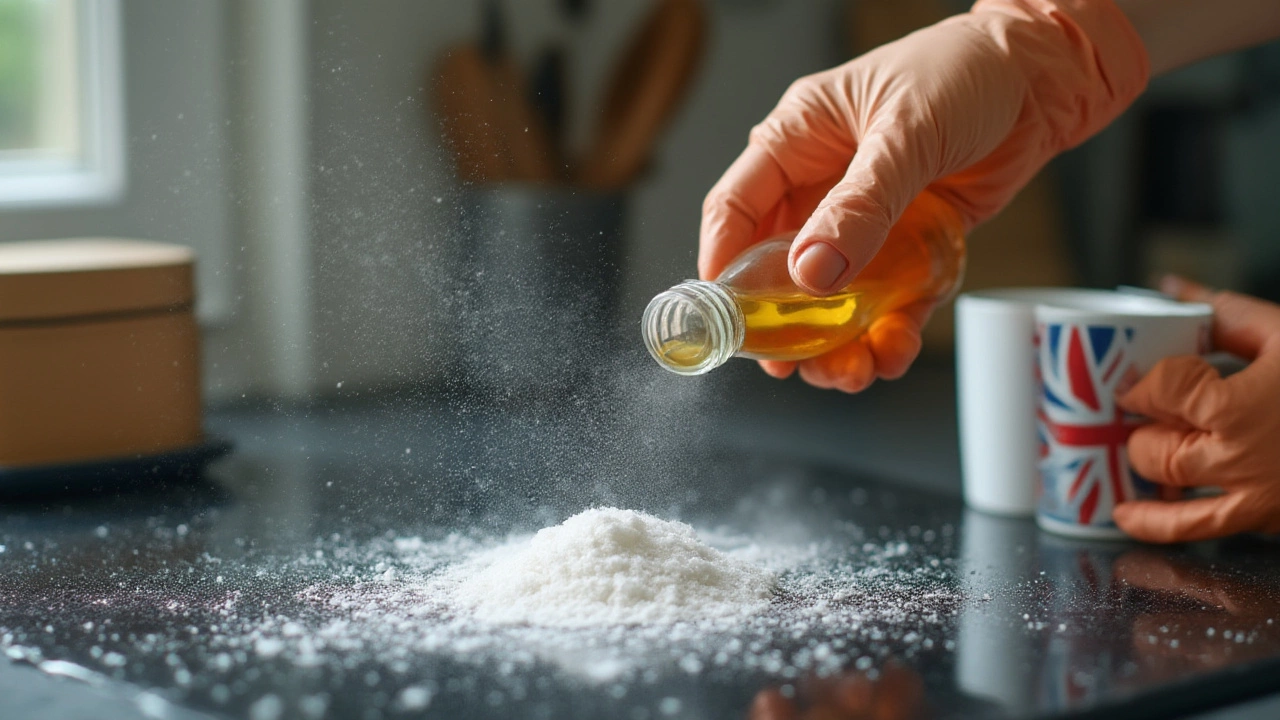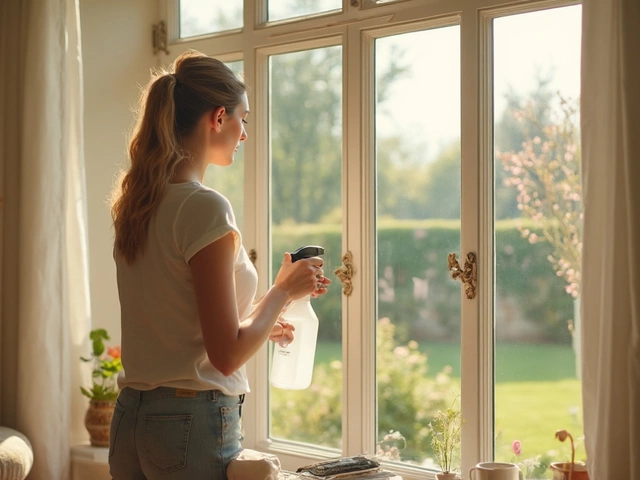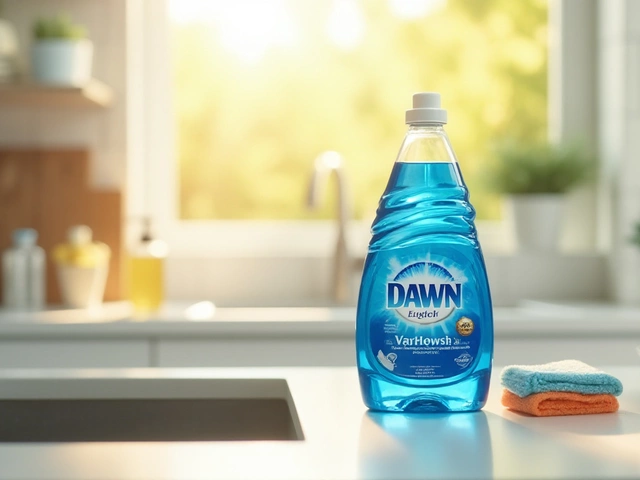Ever twirled a bottle of vinegar and shook a box of baking soda, hoping for a miracle in your greasy kitchen? There’s something almost magical about watching the fizz—and you hope, the disappearing grime. But do these two pantry staples really stand a chance against that enemy clinging to your stovetop, pans, or kitchen tiles?
The Science Behind Baking Soda and Vinegar
Baking soda (sodium bicarbonate) and vinegar (acetic acid) have long been the darlings of DIY cleaning. When you mix them, you get an impressive volcanic show: fizzing, bubbling, and a quick release of carbon dioxide. What’s actually happening here is a simple acid–base reaction. Baking soda is a weak base; vinegar is a mild acid. Together, they create water, carbon dioxide, and a salt called sodium acetate.
This fizzy chemical show grabs our attention, but does it actually clean grease? Here’s where it gets interesting. Grease is mostly made up of fats and oils, which are long-chain molecules and aren’t easily broken down by acid and base reactions. Baking soda alone is mildly abrasive and alkaline, so it can help loosen grime and some fats—great if you need a gentle scrub. Vinegar, meanwhile, is awesome at breaking down minerals and tacking limescale, but oils don't budge much in its presence.
Studies by home cleaning experts and chemists (yes, they exist) confirm: the fizz is cool to watch, but the magic of grease-fighting isn’t actually in the bubble. Instead, the two ingredients mostly neutralize each other. You end up with a non-offensive salty water that’s less effective as a cleaning solution than either ingredient used solo.
There's a catch, though. Used properly (one after the other, not mixed together), they still have their place in fighting surface mess. It's just not the instant grease zapper many hope for.
How Grease Breaks Down—And What Works Best
So if the famous duo isn’t really vaporizing grease, what does? Grease is stubborn because it’s, well, designed to be. Oils repel water. They stick, cling, and resist everything except time, heat, and proper cleaning chemistry. That’s why detergents (think dish soap) work: they have molecules called surfactants that wrap around oil droplets and help water rinse them away.
Baking soda provides a mild scratch, helping break up sticky surfaces and neutralizing acidic odors. A sprinkle of it on a greasy stovetop does make scrubbing easier. Vinegar can help cut through leftover residue after the bulk of the grease is gone, especially when there’s hard water stains mixed with your mess. But don’t expect them to deep-clean a fat-splattered oven door if you just toss them together and walk away.
Here’s a good rule: use baking soda as your scrub, then apply vinegar to rinse afterward, not at the same time. For really baked-on grease—say, the kind you find in rental kitchens or behind your fryer—commercial degreasers or hot, soapy water still top the charts. According to a 2023 survey by Consumer Reports, 85% of people who successfully tackled heavy kitchen grease used dish soap or specialized degreasers, with natural alternatives (baking soda, vinegar) coming in as helpful, but not main, tools.

When to Use Baking Soda and Vinegar for Grease
Don’t rush to throw them out yet. Both baking soda and vinegar have places where they shine, especially for light grease or as maintenance cleaners. For example, a greasy microwave plate can be tackled with a baking soda paste. Just sprinkle a generous amount on the surface, splash with a little water, and use a damp sponge to spread and scrub. Streaks come out, and so do smells.
Afterwards, a light wipe-down with vinegar (mixed 50/50 with water) can help remove any lingering film and keep things sparkling. For stovetops, sprinkle baking soda first, wait a few minutes, then spray with vinegar. Let the fizz do its thing for a bit—this can help lift up stuck-on bits. Wipe clean with a cloth. It won't dissolve thick grease outright, but repeated use loosens residue without harsh chemicals.
This combo also works for kitchen drains, not by dissolving grease, but by helping shift minor buildup and neutralize odors. Pour ½ cup baking soda down the drain, followed by 1 cup vinegar, cover while it fizzes, then rinse with boiling water. It’s not a fix for heavy, greasy clog, but it does prolong the time between serious drain issues.
Real Life Examples, Stats, and a Side-by-Side Comparison
It’s easy to hear grand claims from blogs and TikTok videos, but hard science is less flashy. The U.S. Department of Agriculture actually recommends hot, soapy water for kitchen grease—no mention of fizzy bombs.
But let’s compare the classic kitchen cleaners side-by-side, so you know what to reach for and when.
| Cleaner | Main Grease Action | Best For | Limitations |
|---|---|---|---|
| baking soda | Abrasive, absorbs oils | Light mess, odor removal, maintenance | Slow on thick grease, needs scrubbing |
| vinegar | Lifts mineral stains, deodorizes | After scrubbing, rinsing, shine | Minimal effect on oil/grease alone |
| dish soap | Breaks down grease with surfactants | Everyday washing, heavy grease | Can leave residue if not rinsed well |
| commercial degreaser | Strong solvents, quick action | Ovens, grills, range hoods, stuck-on fat | Usually not eco-friendly, may irritate skin |
If you’re after eco-friendly cleaning, baking soda and vinegar remain top choices. They’re safe, don’t produce fumes, and are cheap. But if your goal is that squeaky-clean after a winter’s worth of fried food, don't expect a miracle.

Practical Cleaning Tips and Tricks
Want the best results without reaching for aggressive chemicals? Here’s how to make the most of baking soda and vinegar in your cleaning routine:
- For greasy pans: After pouring off excess oil, sprinkle on baking soda and add a few drops of water. Let it sit for 10 minutes, then scrub with a soft sponge. Rinse with hot water and dry.
- For microwave splatters: Mix 1/4 cup vinegar with 1 cup water in a microwave-safe bowl. Heat on high until steamy (about 3-5 minutes). Carefully remove; wipe inside with a damp cloth.
- For stovetop maintenance: Sprinkle dry baking soda on cool surfaces, spray lightly with vinegar, and let bubble for five minutes. Wipe away loosened buildup with a microfiber cloth.
- For vent filters: Submerge metal filters in a sink filled with hot, soapy water, add a sprinkle of baking soda, and soak 20 minutes. Rinse under hot water.
- For drains: Use the baking soda and vinegar trick as a monthly maintenance routine, but don’t expect it to clear major fat blockages.
Remember, patience and elbow grease are key, whatever method you use. For regular kitchen upkeep, these natural cleansers keep surfaces fresh while dodging harsh fumes. And hey, even if you don’t melt away thick grease instantly, at least you’re skipping those scary warning labels on commercial sprays.
Bottom line: baking soda and vinegar make a fantastic eco-friendly team for everyday cleaning and light grease. The real shine is in preventing messes rather than tackling disaster zones. If you want that sparkling stovetop, daily wipe-downs with soapy water and touch-ups with these pantry staples do wonders—no chemistry degree required.




